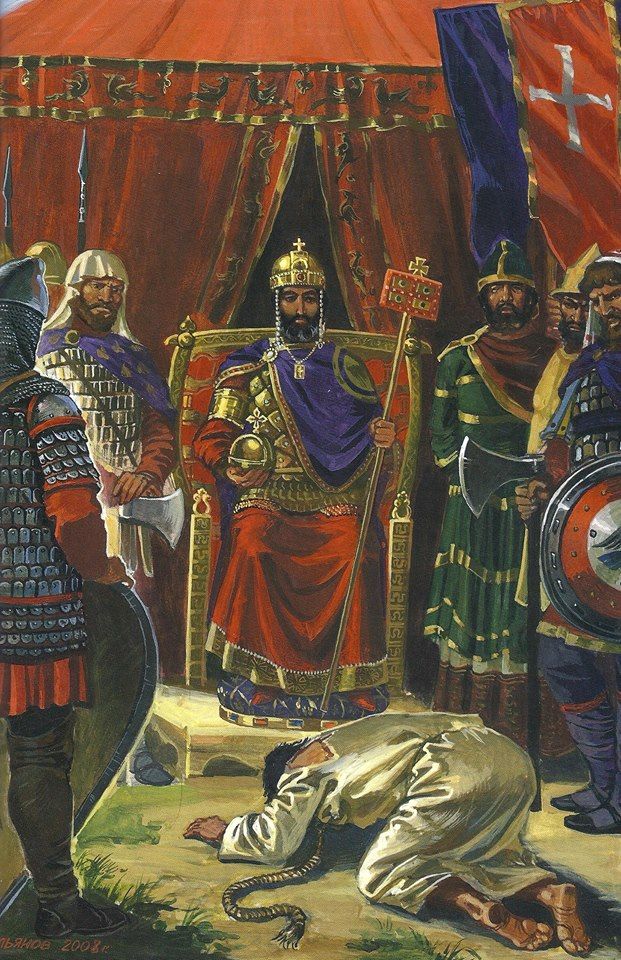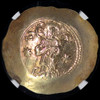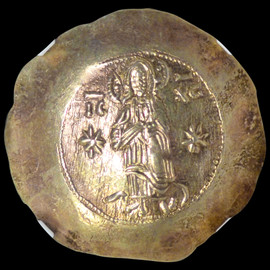Manuel I Comnenus (AD 1143-1180). EL aspron trachy (31mm, 4.59 gm, 6h). NGC MS 4/5 - 4/5. Constantinople, AD 1160-1164. IC-XC (barred), Christ standing facing on dais, bearded, wearing nimbus cruciger with five pellets in limbs, pallium and colobium, raising right hand in benediction, book of Gospels in left; eight-pointed star to either side / M-AN-ΩHΛ-O / ΘЄ/Ο/Δ/Ω/Ρ/OC, Manuel I, bearded (on left) and St. Theodore, bearded and nimbate (on right) both standing facing, jointly holding patriarchal cross with three small pellets on shaft and large globus on base between them, emperor wearing crown, divitision and loros, right hand on pommel of sheathed sword on hip, saint wearing military attire with left hand on pommel of sheathed sword at hip. Sear 1959.
Struck during a period of great tension between the Byzantine Empire and the Western European Crusader forces, this coin is symbolic of Manuel I's desire to preserve the power and independence of the Byzantine realm from the ever-threatening "Latins." The patriarchal cross on the reverse of the coin, a major symbol of Orthodox Christianity, would have signaled Manuel's desire to protect his people, empire, and faith from the hostile Roman Catholic Crusaders, as would the depiction of St. Theodore, a popular saint in the Byzantine cultural sphere.
|

Manuel I Komnenos (Greek: Μανουήλ Κομνηνός; 28 November 1118 – 24 September 1180), Latinized Comnenus, also called Porphyrogennetos ("born in the purple"), was a Byzantine emperor of the 12th century who reigned over a crucial turning point in the history of Byzantium and the Mediterranean. His reign saw the last flowering of the Komnenian restoration, during which the Byzantine Empire had seen a resurgence of its military and economic power, and had enjoyed a cultural revival.
Eager to restore his empire to its past glories as the superpower of the Mediterranean world, Manuel pursued an energetic and ambitious foreign policy. In the process he made alliances with Pope Adrian IV and the resurgent West. He invaded the Norman Kingdom of Sicily, although unsuccessfully, being the last Eastern Roman emperor to attempt reconquests in the western Mediterranean. The passage of the potentially dangerous Second Crusade through his empire was adroitly managed. Manuel established a Byzantine protectorate over the Crusader states of Outremer. Facing Muslim advances in the Holy Land, he made common cause with the Kingdom of Jerusalem and participated in a combined invasion of Fatimid Egypt. Manuel reshaped the political maps of the Balkans and the eastern Mediterranean, placing the kingdoms of Hungary and Outremer under Byzantine hegemony and campaigning aggressively against his neighbours both in the west and in the east.
However, towards the end of his reign, Manuel's achievements in the east were compromised by a serious defeat at Myriokephalon, which in large part resulted from his arrogance in attacking a well-defended Seljuk position. Although the Byzantines recovered and Manuel concluded an advantageous peace with Sultan Kilij Arslan II, Myriokephalon proved to be the final, unsuccessful effort by the empire to recover the interior of Anatolia from the Turks.
Called ho Megas (ὁ Μέγας, translated as "the Great") by the Greeks, Manuel is known to have inspired intense loyalty in those who served him. He also appears as the hero of a history written by his secretary, John Kinnamos, in which every virtue is attributed to him. Manuel, who was influenced by his contact with western Crusaders, enjoyed the reputation of "the most blessed emperor of Constantinople" in parts of the Latin world as well.[1] Modern historians, however, have been less enthusiastic about him. Some of them assert that the great power he wielded was not his own personal achievement, but that of the dynasty he represented; they also argue that, since Byzantine imperial power declined catastrophically after Manuel's death, it is only natural to look for the causes of this decline in his reign.
|












